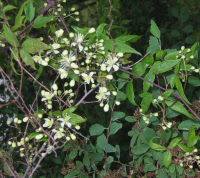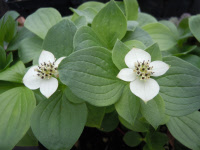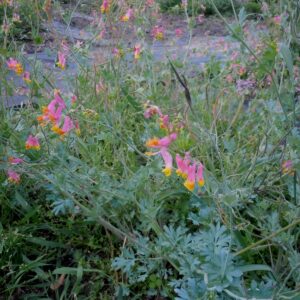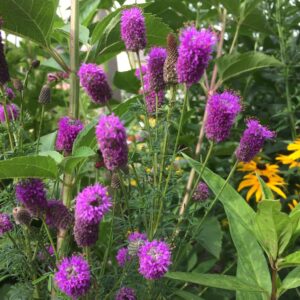Wisconsin Native
Showing 33–40 of 108 results
-
Clematis occidentalis var. occidentalis Purple clematis. Short-styled bluebell Z 4-8
Four petaled (sepals), purple, down-facing, 4” long bells flowering in spring encircling a bundle of styles and stamens.
OUT OF STOCK – EMAIL FOR AVAILABILITY
Four petaled (sepals), purple, down-facing, 4” long bells flowering in spring encircling a bundle of styles and stamens.
Size: 3-12” x 2’
Care: sun to shade in moist well-drained to well-drained, alkaline soil
Native: Maine to Minnesota south to Illinois and South Carolina and all states between, Wisconsin native. Endangered in three states; “of special concern” in Wisconsin and gone in Ohio.The species first described by Danish botanist Jens Wilken Hornemann in 1805. var. occidentalis is the eastern variety of the species (peculiarly called occidentalis meaning west.) The species and other varieties are native in western US.
-
Clematis virginiana Virgin’s bower, Devil’s darning needles Z 4-8
July-September star-like white blossoms
OUT OF STOCK
July-September star-like white blossoms cover this vine – good for clambering up small trees.
Size: 12-20’ x 4’
Care: Sun to shade moist well-drained soil. Flowers on new stems so cut back in late winter or early spring to 6-8” above the ground.
Native: Nova Scotia to Georgia and as far west as Kansas, Wisconsin nativeThe genus Clematis was named by Dioscordes, physician in Nero’s army, from “klema” meaning climbing plant. One of 1st No. American plants sent to Europe – grew in Tradescant the Elder’s South Lambeth nursery in 1634. Grown by Jefferson at Monticello in 1807. Described by Breck in his 1851 book The Flower Garden: “The flowers are white borne upon cymes, and make a handsome appearance.” Cherokee mixed this plant with milkweed to remedy backaches. A root extract cured stomach aches, nervous conditions and kidney ailments. For the Iroquois powdered root fixed venereal disease sores and an extract of the stem brought on strange dreams. Pressed specimen in Emily Dickinson’s herbarium.
-
Coreopsis lanceolata Lanceleaf tickseed Z 4-9
Golden yellow daisy-like flowers with pleated petals, jagged at their tips, blooming June to September
OUT OF STOCK
Golden yellow daisy-like flowers with pleated petals, jagged at their tips, blooming June to September
Size: 24” x 18”
Care: sun to part shade, moist well-drained soil
Native: Central and southeastern U.S., WI native
Wildlife Value: caterpillar food sourceCoreopsis is Greek meaning “buglike” referring to the seeds looking like little black bugs. Cultivated in America since the 1700’s. Sent to England in 1724 by English naturalist Mark Catesby (1683-1749).
-
Cornus canadensis Bunchberry, Creeping dogwood Z 2-7Cornus canadensis syn. Chamaepericlymenum canadensis Bunchberry, Creeping dogwood Z 2-7
Four white, pointed petal-like bracts in spring and showy scarlet berries in fall
OUT OF STOCK
Four white, pointed petal-like bracts in spring and showy scarlet berries in fall
Size: 6” x spreading slowly
Care: part shade in moist, ACIDIC soil. Needs moisture to establish
Native: Northern areas from the east to the west coasts of No. America, Wisconsin native.
Wildlife Value: Host for the caterpillar of the Spring azure butterfly. Pollen and nectar for many bees, wasps, ants, butterflies and beetles.Flowers open faster than any other flower, in less than ½ millisecond. Abnaki Indians used it to cure side pains. Algonquin made a cathartic tea, cured colds, and stomach aches with this. Delaware reduced body pains with it. Chippewa, Cree and Eskimo smoked the berries. Probably 1st collected for gardens by John Bartram (1699-1776). Offered for sale at his nursery near Philadelphia. Sent to Dr. Fothergill in London in 1774. “One of the prettiest plants for the bog garden or the cool parts of the rock garden.” William Robinson 1899. Pressed specimen in Emily Dickinson’s herbarium.
-
Corydalis sempervirens syn. Capnoides sempervirens, Fumitory, Rock harlequin RESEEDING SHORT-LIVED PERENNIAL
Pink tube-shaped flowers with flaring yellow ends bloom from spring to summer
RESEEDING SHORT-LIVED PERENNIAL
Pink tube-shaped flowers with flaring yellow ends bloom from spring to summer
Size: 10-12” x 10-12”
Care: Sun to part shade in moist well drained soil
Native: from Nova Scotia west to Alaska, south to North Carolina, Wisconsin nativeCorydalis is Greek for “lark” korydalos, referring to the shape of flower resembling a lark’s spur. First described and named (name now changed) in 1753. Pressed specimen in Emily Dickinson’s herbarium.
-
Corylus americana American Hazelnut, Filbert Z 4-9
In spring, showy male flowers on 2-3" long catkins. Female flowers appear in small, reddish catkins grow into half inch long, egg-shaped edible nuts. Fall color ranges from orange, rose, purplish red, yellow and green.
In spring, showy male flowers on 2-3″ long catkins. Female flowers appear in small, reddish catkins grow into half inch long, egg-shaped edible nuts. Fall color ranges from orange, rose, purplish red, yellow and green.
Size: 10-16’ x 8-1’
Care: sun in any soil
Native: E. North America including Wisconsin
Wildlife Value: Exceptionally high value to wildlife. Pheasant, Quail, Turkey, Grouse, Turkey & Blue Jay and small animals eat the nuts. Pollen source for bees, host to many caterpillars both butterflies and moths. Branches make good nesting sites for songbirds. Black walnut tolerant.Described by Thomas Walter in 1788. Food for several Native American tribes. Medicinal for Cherokee, Iroquois, Menominee, Meskwaki and Ojibwa, to remedy hives, fever, headaches, pain of baby’s teething, hay fever and induce vomiting.
**LISTED AS OUT OF STOCK BECAUSE WE DO NOT SHIP THIS ITEM. IT IS AVAILABLE FOR PURCHASE AT OUR RETAIL LOCATION.
-
Dalea aurea syn Parosela aurea Golden prairie clover Z 5-9
Cone-shaped fuzzy yellow flower spikes rise above sparse foliage in April-June
ARCHIVED
Note: This is a plant not currently for sale. This is an archive page preserved for informational use.
Cone-shaped fuzzy yellow flower spikes rise above sparse foliage in April-June
Size: 1-3’ x 1’
Care: sun in dry soil
Native: West US from TX to WY
Wildlife Value: Attracts bees, butterflies
Size: Native Americans used Golden Prairie-clover to treat diarrhea and colicCollected and described by Thomas Nuttall, 1813.
-
Dalea purpurea syn. Petalostemon purpurea Violet prairie clover Z 4-9
Vase shaped clump with wands of violet to purple encircling tall coneheads mid-summer
Vase shaped clump with wands of violet to purple encircling tall coneheads mid-summer
Size: 2’ x 18”
Care: full sun in well-drained to moist well-drained soil.
Native: Canada to Texas, Wisconsin native
Wildlife Value: Host for caterpillars of Dogface Sulphur, Striped blue & Mexican blue butterflies. Supports over 80 bee species including endangered Rusty patched Bumble BeesDalea named to honor English botanist Dr. Samuel Dale (1659- 1739.) Chippewa, Meskwaki and Navajo used medicinally – as remedies for heart ailments, pneumonia, diarrhea and measles. Comanche and Lakota chewed the root like gum, for its sweet taste. Sioux combined it with Amorpha canescens, Leadplant to ambush bison. Sioux also treated fevers and stomach disorders with an infusion made from the plant. Pawnee made brooms from the flexible stems. 1st collected by French botanist André Michaux (1746-1802) who spent 11 years in America collecting hundreds of new plants.





